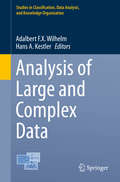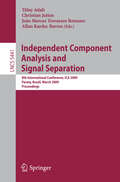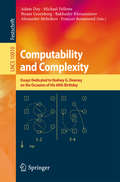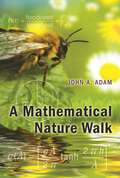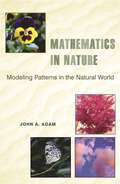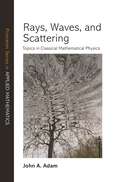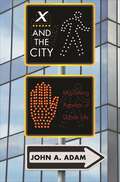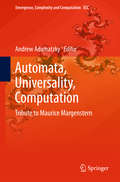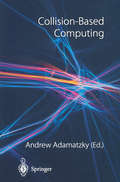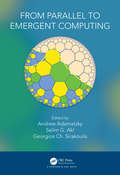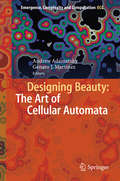- Table View
- List View
Functional Equations: History, Applications and Theory (Mathematics and Its Applications #12)
by J. AczélApproach your problems from It isn't that they can't see the right end and begin with the solution. It is that they the answers. Then one day, can't see the problem. perhaps you will find the G.K. Chesterton. The Scandal of final question. Father Brown 'The Point of a Pin' . 'The Hermit Clad ~n Crane Feathers' in R. van Gulik's The Chinese Haze Murders. Growing specialization and diversification have brought a host of monographs and textbooks on increasingly specialized topics. However, the "tree" of knowledge of mathematics and related fields does not grow only by putting forth new branches. It also happens, quite often in fact, that branches which were thought to be completely disparate are suddenly seen to be related. Further, the kind and level of sophistication of mathe matics applied in various sciences has changed drastically in recent years: measure theory is used (non-trivially) ~n re gional and theoretical economics; algebraic geometry interacts with physics; the Minkowsky lemma, coding theory and the structure of water meet one another in packing and covering theory; quantum fields, crystal defects and mathematical pro gramming profit from homotopy theory; Lie algebras are rele vant to filtering; and prediction and electrical en~ineering can use Stein spaces. And in addition to this there are such new emerging subdisciplines as "completely integrable systems", "chaos, synergetics and large-scale order", which are almost impossible to fit into the existinf, classifi~ation schemes. They draw upon widely different sections of mathematics.
A Short Course on Functional Equations: Based Upon Recent Applications to the Social and Behavioral Sciences (Theory and Decision Library B #3)
by J. AczélRecently I taught short courses on functional equations at several universities (Barcelona, Bern, Graz, Hamburg, Milan, Waterloo). My aim was to introduce the most important equations and methods of solution through actual (not artifi cial) applications which were recent and with which I had something to do. Most of them happened to be related to the social or behavioral sciences. All were originally answers to questions posed by specialists in the respective applied fields. Here I give a somewhat extended version of these lectures, with more recent results and applications included. As previous knowledge just the basic facts of calculus and algebra are supposed. Parts where somewhat more (measure theory) is needed and sketches of lengthier calcula tions are set in fine print. I am grateful to Drs. J. Baker (Waterloo, Ont.), W. Forg-Rob (Innsbruck, Austria) and C. Wagner (Knoxville, Tenn.) for critical remarks and to Mrs. Brenda Law for care ful computer-typing of the manuscript (in several versions). A note on numbering of statements and references: The numbering of Lemmata, Propositions, Theorems, Corollaries and (separately) formulae starts anew in each section. If quoted in another section, the section number is added, e.g. (2.10) or Theorem 1.2. References are quoted by the last names of the authors and the last two digits of the year, e.g. Daroczy-Losonczi [671. 1 1. An aggregation theorem for allocation problems. Cauchy equation for single-and multiplace functions. Two extension theorems.
Technological Progress, Income Distribution, and Unemployment: Theory and Empirics (SpringerBriefs in Economics)
by Hideyuki Adachi Kazuyuki Inagaki Tamotsu Nakamura Yasuyuki OsumiThis volume develops original methods of analyzing biased technological progress in the theory and empirics of economic growth and income distribution. Motivated by sharp increases in wage and income inequalities in the world since the beginning of the new century, many macroeconomists have begun to realize the importance of biased technological changes. However, the comprehensive explanations have not yet appeared. This volume analyzes the effects of factor-biased technological progress on growth and income distribution and shows that long-run trends of the capital-income ratio and capital share of income consistent with Piketty’s 2014 empirical results emerge. Incorporating the modified version of induced innovation theory into the standard neoclassical growth model, it also explains the long-run fluctuations of growth and income distribution consistent with the data shown in Piketty. Introducing a wage-setting function, the neoclassical growth model is modified to account for unemployment as well as to examine the dynamics of unemployment and the labor share of income under biased technological progress. Applying a new econometric method to Japanese industrial data, the authors test the key assumptions employed and important results derived in the theoretical part of this book.
Matrix-Based Introduction to Multivariate Data Analysis
by Kohei AdachiThis is the first textbook that allows readers who may be unfamiliar with matrices to understand a variety of multivariate analysis procedures in matrix forms. By explaining which models underlie particular procedures and what objective function is optimized to fit the model to the data, it enables readers to rapidly comprehend multivariate data analysis. Arranged so that readers can intuitively grasp the purposes for which multivariate analysis procedures are used, the book also offers clear explanations of those purposes, with numerical examples preceding the mathematical descriptions.Supporting the modern matrix formulations by highlighting singular value decomposition among theorems in matrix algebra, this book is useful for undergraduate students who have already learned introductory statistics, as well as for graduate students and researchers who are not familiar with matrix-intensive formulations of multivariate data analysis.The book begins by explaining fundamental matrix operations and the matrix expressions of elementary statistics. Then, it offers an introduction to popular multivariate procedures, with each chapter featuring increasing advanced levels of matrix algebra. Further the book includes in six chapters on advanced procedures, covering advanced matrix operations and recently proposed multivariate procedures, such as sparse estimation, together with a clear explication of the differences between principal components and factor analyses solutions. In a nutshell, this book allows readers to gain an understanding of the latest developments in multivariate data science.
Matrix-Based Introduction to Multivariate Data Analysis
by Kohei AdachiThis book enables readers who may not be familiar with matrices to understand a variety of multivariate analysis procedures in matrix forms. Another feature of the book is that it emphasizes what model underlies a procedure and what objective function is optimized for fitting the model to data. The author believes that the matrix-based learning of such models and objective functions is the fastest way to comprehend multivariate data analysis. The text is arranged so that readers can intuitively capture the purposes for which multivariate analysis procedures are utilized: plain explanations of the purposes with numerical examples precede mathematical descriptions in almost every chapter. This volume is appropriate for undergraduate students who already have studied introductory statistics. Graduate students and researchers who are not familiar with matrix-intensive formulations of multivariate data analysis will also find the book useful, as it is based on modern matrix formulations with a special emphasis on singular value decomposition among theorems in matrix algebra. The book begins with an explanation of fundamental matrix operations and the matrix expressions of elementary statistics, followed by the introduction of popular multivariate procedures with advancing levels of matrix algebra chapter by chapter. This organization of the book allows readers without knowledge of matrices to deepen their understanding of multivariate data analysis.
Analysis of Large and Complex Data (Studies in Classification, Data Analysis, and Knowledge Organization #0)
by Adalbert F.X. Wilhelm Hans A. KestlerThis book offers a snapshot of the state-of-the-art in classification at the interface between statistics, computer science and application fields. The contributions span a broad spectrum, from theoretical developments to practical applications; they all share a strong computational component. The topics addressed are from the following fields: Statistics and Data Analysis; Machine Learning and Knowledge Discovery; Data Analysis in Marketing; Data Analysis in Finance and Economics; Data Analysis in Medicine and the Life Sciences; Data Analysis in the Social, Behavioural, and Health Care Sciences; Data Analysis in Interdisciplinary Domains; Classification and Subject Indexing in Library and Information Science. The book presents selected papers from the Second European Conference on Data Analysis, held at Jacobs University Bremen in July 2014. This conference unites diverse researchers in the pursuit of a common topic, creating truly unique synergies in the process.
Independent Component Analysis and Signal Separation: 8th International Conference, ICA 2009, Paraty, Brazil, March 15-18, 2009, Proceedings (Lecture Notes in Computer Science #5441)
by Tulay Adali Christian Jutten Joao Marcos Travassos Romano Allan Kardec BarrosThis book constitutes the refereed proceedings of the 8th International Conference on Independent Component Analysis and Signal Separation, ICA 2009, held in Paraty, Brazil, in March 2009. The 97 revised papers presented were carefully reviewed and selected from 137 submissions. The papers are organized in topical sections on theory, algorithms and architectures, biomedical applications, image processing, speech and audio processing, other applications, as well as a special session on evaluation.
Computability and Complexity: Essays Dedicated to Rodney G. Downey on the Occasion of His 60th Birthday (Lecture Notes in Computer Science #10010)
by Adam Day, Michael Fellows, Noam Greenberg, Bakhadyr Khoussainov, Alexander Melnikov and Frances RosamondThis Festschrift is published in honor of Rodney G. Downey, eminent logician and computer scientist, surfer and Scottish country dancer, on the occasion of his 60th birthday.The Festschrift contains papers and laudations that showcase the broad and important scientific, leadership and mentoring contributions made by Rod during his distinguished career. The volume contains 42 papers presenting original unpublished research, or expository and survey results in Turing degrees, computably enumerable sets, computable algebra, computable model theory, algorithmic randomness, reverse mathematics, and parameterized complexity, all areas in which Rod Downey has had significant interests and influence. The volume contains several surveys that make the various areas accessible to non-specialists while also including some proofs that illustrate the flavor of the fields.
A Mathematical Nature Walk
by John A. AdamHow heavy is that cloud? Why can you see farther in rain than in fog? Why are the droplets on that spider web spaced apart so evenly? If you have ever asked questions like these while outdoors, and wondered how you might figure out the answers, this is a book for you. An entertaining and informative collection of fascinating puzzles from the natural world around us, A Mathematical Nature Walk will delight anyone who loves nature or math or both. John Adam presents ninety-six questions about many common natural phenomena--and a few uncommon ones--and then shows how to answer them using mostly basic mathematics. Can you weigh a pumpkin just by carefully looking at it? Why can you see farther in rain than in fog? What causes the variations in the colors of butterfly wings, bird feathers, and oil slicks? And why are large haystacks prone to spontaneous combustion? These are just a few of the questions you'll find inside. Many of the problems are illustrated with photos and drawings, and the book also has answers, a glossary of terms, and a list of some of the patterns found in nature. About a quarter of the questions can be answered with arithmetic, and many of the rest require only precalculus. But regardless of math background, readers will learn from the informal descriptions of the problems and gain a new appreciation of the beauty of nature and the mathematics that lies behind it.
A Mathematical Nature Walk (PDF)
by John A. AdamHow heavy is that cloud? Why can you see farther in rain than in fog? Why are the droplets on that spider web spaced apart so evenly? If you have ever asked questions like these while outdoors, and wondered how you might figure out the answers, this is a book for you. An entertaining and informative collection of fascinating puzzles from the natural world around us, A Mathematical Nature Walk will delight anyone who loves nature or math or both. John Adam presents ninety-six questions about many common natural phenomena--and a few uncommon ones--and then shows how to answer them using mostly basic mathematics. Can you weigh a pumpkin just by carefully looking at it? Why can you see farther in rain than in fog? What causes the variations in the colors of butterfly wings, bird feathers, and oil slicks? And why are large haystacks prone to spontaneous combustion? These are just a few of the questions you'll find inside. Many of the problems are illustrated with photos and drawings, and the book also has answers, a glossary of terms, and a list of some of the patterns found in nature. About a quarter of the questions can be answered with arithmetic, and many of the rest require only precalculus. But regardless of math background, readers will learn from the informal descriptions of the problems and gain a new appreciation of the beauty of nature and the mathematics that lies behind it.
Mathematics in Nature: Modeling Patterns in the Natural World
by John A. AdamFrom rainbows, river meanders, and shadows to spider webs, honeycombs, and the markings on animal coats, the visible world is full of patterns that can be described mathematically. Examining such readily observable phenomena, this book introduces readers to the beauty of nature as revealed by mathematics and the beauty of mathematics as revealed in nature. Generously illustrated, written in an informal style, and replete with examples from everyday life, Mathematics in Nature is an excellent and undaunting introduction to the ideas and methods of mathematical modeling. It illustrates how mathematics can be used to formulate and solve puzzles observed in nature and to interpret the solutions. In the process, it teaches such topics as the art of estimation and the effects of scale, particularly what happens as things get bigger. Readers will develop an understanding of the symbiosis that exists between basic scientific principles and their mathematical expressions as well as a deeper appreciation for such natural phenomena as cloud formations, halos and glories, tree heights and leaf patterns, butterfly and moth wings, and even puddles and mud cracks. Developed out of a university course, this book makes an ideal supplemental text for courses in applied mathematics and mathematical modeling. It will also appeal to mathematics educators and enthusiasts at all levels, and is designed so that it can be dipped into at leisure.
Mathematics in Nature: Modeling Patterns in the Natural World
by John A. AdamFrom rainbows, river meanders, and shadows to spider webs, honeycombs, and the markings on animal coats, the visible world is full of patterns that can be described mathematically. Examining such readily observable phenomena, this book introduces readers to the beauty of nature as revealed by mathematics and the beauty of mathematics as revealed in nature. Generously illustrated, written in an informal style, and replete with examples from everyday life, Mathematics in Nature is an excellent and undaunting introduction to the ideas and methods of mathematical modeling. It illustrates how mathematics can be used to formulate and solve puzzles observed in nature and to interpret the solutions. In the process, it teaches such topics as the art of estimation and the effects of scale, particularly what happens as things get bigger. Readers will develop an understanding of the symbiosis that exists between basic scientific principles and their mathematical expressions as well as a deeper appreciation for such natural phenomena as cloud formations, halos and glories, tree heights and leaf patterns, butterfly and moth wings, and even puddles and mud cracks. Developed out of a university course, this book makes an ideal supplemental text for courses in applied mathematics and mathematical modeling. It will also appeal to mathematics educators and enthusiasts at all levels, and is designed so that it can be dipped into at leisure.
Rays, Waves, and Scattering: Topics in Classical Mathematical Physics
by John A. AdamThis one-of-a-kind book presents many of the mathematical concepts, structures, and techniques used in the study of rays, waves, and scattering. Panoramic in scope, it includes discussions of how ocean waves are refracted around islands and underwater ridges, how seismic waves are refracted in the earth's interior, how atmospheric waves are scattered by mountains and ridges, how the scattering of light waves produces the blue sky, and meteorological phenomena such as rainbows and coronas.Rays, Waves, and Scattering is a valuable resource for practitioners, graduate students, and advanced undergraduates in applied mathematics, theoretical physics, and engineering. Bridging the gap between advanced treatments of the subject written for specialists and less mathematical books aimed at beginners, this unique mathematical compendium features problems and exercises throughout that are geared to various levels of sophistication, covering everything from Ptolemy's theorem to Airy integrals (as well as more technical material), and several informative appendixes.Provides a panoramic look at wave motion in many different contextsFeatures problems and exercises throughoutIncludes numerous appendixes, some on topics not often coveredAn ideal reference book for practitionersCan also serve as a supplemental text in classical applied mathematics, particularly wave theory and mathematical methods in physics and engineeringAccessible to anyone with a strong background in ordinary differential equations, partial differential equations, and functions of a complex variable
X and the City: Modeling Aspects of Urban Life
by John A. AdamX and the City, a book of diverse and accessible math-based topics, uses basic modeling to explore a wide range of entertaining questions about urban life. How do you estimate the number of dental or doctor's offices, gas stations, restaurants, or movie theaters in a city of a given size? How can mathematics be used to maximize traffic flow through tunnels? Can you predict whether a traffic light will stay green long enough for you to cross the intersection? And what is the likelihood that your city will be hit by an asteroid? Every math problem and equation in this book tells a story and examples are explained throughout in an informal and witty style. The level of mathematics ranges from precalculus through calculus to some differential equations, and any reader with knowledge of elementary calculus will be able to follow the materials with ease. There are also some more challenging problems sprinkled in for the more advanced reader. Filled with interesting and unusual observations about how cities work, X and the City shows how mathematics undergirds and plays an important part in the metropolitan landscape.
X and the City: Modeling Aspects of Urban Life
by John A. AdamX and the City, a book of diverse and accessible math-based topics, uses basic modeling to explore a wide range of entertaining questions about urban life. How do you estimate the number of dental or doctor's offices, gas stations, restaurants, or movie theaters in a city of a given size? How can mathematics be used to maximize traffic flow through tunnels? Can you predict whether a traffic light will stay green long enough for you to cross the intersection? And what is the likelihood that your city will be hit by an asteroid? Every math problem and equation in this book tells a story and examples are explained throughout in an informal and witty style. The level of mathematics ranges from precalculus through calculus to some differential equations, and any reader with knowledge of elementary calculus will be able to follow the materials with ease. There are also some more challenging problems sprinkled in for the more advanced reader. Filled with interesting and unusual observations about how cities work, X and the City shows how mathematics undergirds and plays an important part in the metropolitan landscape.
A Survey of Models for Tumor-Immune System Dynamics (Modeling and Simulation in Science, Engineering and Technology)
by John A. Adam Nicola BellomoMathematical Modeling and Immunology An enormous amount of human effort and economic resources has been directed in this century to the fight against cancer. The purpose, of course, has been to find strategies to overcome this hard, challenging and seemingly endless struggle. We can readily imagine that even greater efforts will be required in the next century. The hope is that ultimately humanity will be successful; success will have been achieved when it is possible to activate and control the immune system in its competition against neoplastic cells. Dealing with the above-mentioned problem requires the fullest pos sible cooperation among scientists working in different fields: biology, im munology, medicine, physics and, we believe, mathematics. Certainly, bi ologists and immunologists will make the greatest contribution to the re search. However, it is now increasingly recognized that mathematics and computer science may well able to make major contributions to such prob lems. We cannot expect mathematicians alone to solve fundamental prob lems in immunology and (in particular) cancer research, but valuable sup port, however modest, can be provided by mathematicians to the research aspirations of biologists and immunologists working in this field.
MATLAB und Mathematik kompetent einsetzen: Eine Einführung für Ingenieure und Naturwissenschaftler
by Stefan AdamDas erfolgreiche MATLAB- und Mathematikbuch von Stefan Adam fördert den Aufbau einer fundierten Kompetenz zur Lösung von naturwissenschaftlichen und technischen Berechnungsproblemen. Zusammen mit den Erläuterungen zur Anwendung und Programmierung vom MATLAB wird immer auch ein tiefer Einblick vermittelt in die dahinter stehenden mathematischen Zusammenhänge. Durch viele Beispiele, Übungen und selbst zu erstellende Demonstrationsprogramme wird der Leser angeleitet, sich in der Umgebung von MATLAB kreativ zu bewegen. Das von einem MATrix-LABoratorium ausgegangene Softwarepaket hat sich längst zu einem Mathematik-Laboratorium weiterentwickelt, das weltweit an Universitäten sowie in Forschungs- und Entwicklungsabteilungen eine Spitzenstellung einnimmt. Die zwei Komponenten dieses Buches verstärken sich gegenseitig. Der mathematische Hintergrund fördert einerseits die Merkfähigkeit für die Programmierstrukturen sowie die Entscheidungskompetenz zur Auswahl des besten Berechnungsablaufes. Selbstprogrammierte Lösungsverfahren mit vielfältigen grafischen Darstellungen vertiefen andererseits das Verständnis für oft abstrakte mathematische Zusammenhänge. Für das Arbeiten mit diesem Buch werden weder Vorkenntnisse einer Programmiersprache noch solche zu MATLAB benötigt. Mathematische Themen starten auf dem Niveau, das etwa ein Jahr vor dem Abitur erreicht wird, und steigen in sanften Stufen bis zu den Anforderungen der ersten vier Semester eines Naturwissenschafts- oder Ingenieurstudiums. Starke Querbezüge zu praktischen Problemen und hilfreiche bildhafte Vorstellungen machen die hier präsentierte Mathematik leichter verdaulich. Merkpunkte, Checklisten und Selbst-Tests dienen der Festigung der erworbenen Fähigkeiten und machen das Buch auch hervorragend zum Selbststudium geeignet. * In dieser zweiten Auflage können Teile des ersten Kapitels als MATLAB Crash-Kurs für Ungeduldige oder für Wiedereinsteiger dienen. * Hinweise auf Anwendungen der Toolbox zum Symbolischen Rechnen, also zum Bestimmen einer analytischen Lösung oder zum Umsetzen von Formeln, finden sich über das ganze Buch verteilt. * Im Internet ist unter www.wiley-vch.de/textbooks/ eine Fülle von ergänzendem Material erhältlich
MATLAB und Mathematik kompetent einsetzen: Eine Einführung für Ingenieure und Naturwissenschaftler
by Stefan AdamDas erfolgreiche MATLAB- und Mathematikbuch von Stefan Adam fördert den Aufbau einer fundierten Kompetenz zur Lösung von naturwissenschaftlichen und technischen Berechnungsproblemen. Zusammen mit den Erläuterungen zur Anwendung und Programmierung vom MATLAB wird immer auch ein tiefer Einblick vermittelt in die dahinter stehenden mathematischen Zusammenhänge. Durch viele Beispiele, Übungen und selbst zu erstellende Demonstrationsprogramme wird der Leser angeleitet, sich in der Umgebung von MATLAB kreativ zu bewegen. Das von einem MATrix-LABoratorium ausgegangene Softwarepaket hat sich längst zu einem Mathematik-Laboratorium weiterentwickelt, das weltweit an Universitäten sowie in Forschungs- und Entwicklungsabteilungen eine Spitzenstellung einnimmt. Die zwei Komponenten dieses Buches verstärken sich gegenseitig. Der mathematische Hintergrund fördert einerseits die Merkfähigkeit für die Programmierstrukturen sowie die Entscheidungskompetenz zur Auswahl des besten Berechnungsablaufes. Selbstprogrammierte Lösungsverfahren mit vielfältigen grafischen Darstellungen vertiefen andererseits das Verständnis für oft abstrakte mathematische Zusammenhänge. Für das Arbeiten mit diesem Buch werden weder Vorkenntnisse einer Programmiersprache noch solche zu MATLAB benötigt. Mathematische Themen starten auf dem Niveau, das etwa ein Jahr vor dem Abitur erreicht wird, und steigen in sanften Stufen bis zu den Anforderungen der ersten vier Semester eines Naturwissenschafts- oder Ingenieurstudiums. Starke Querbezüge zu praktischen Problemen und hilfreiche bildhafte Vorstellungen machen die hier präsentierte Mathematik leichter verdaulich. Merkpunkte, Checklisten und Selbst-Tests dienen der Festigung der erworbenen Fähigkeiten und machen das Buch auch hervorragend zum Selbststudium geeignet. * In dieser zweiten Auflage können Teile des ersten Kapitels als MATLAB Crash-Kurs für Ungeduldige oder für Wiedereinsteiger dienen. * Hinweise auf Anwendungen der Toolbox zum Symbolischen Rechnen, also zum Bestimmen einer analytischen Lösung oder zum Umsetzen von Formeln, finden sich über das ganze Buch verteilt. * Im Internet ist unter www.wiley-vch.de/textbooks/ eine Fülle von ergänzendem Material erhältlich
Automata, Universality, Computation: Tribute to Maurice Margenstern (Emergence, Complexity and Computation #12)
by Andrew AdamatzkyThis book is an intellectually stimulating excursion into mathematical machines and structures capable for a universal computation. World top experts in computer science and mathematics overview exciting and intriguing topics of logical theory of monoids, geometry of Gauss word, philosophy of mathematics in computer science, asynchronous and parallel P-systems, decidability in cellular automata, splicing systems, reversible Turing machines, information flows in two-way finite automata, prime generators in automaton arrays, Grossone and Turing machines, automaton models of atomic lattices. The book is full of visually attractive examples of mathematical machines, open problems and challenges for future research. Those interested in the advancement of a theory of computation, philosophy of mathematics, future and emergent computing paradigms, architectures and implementations will find the book vital for their research and development.
Collision-Based Computing
by Andrew AdamatzkyCollision-Based Computing presents a unique overview of computation with mobile self-localized patterns in non-linear media, including computation in optical media, mathematical models of massively parallel computers, and molecular systems. It covers such diverse subjects as conservative computation in billiard ball models and its cellular-automaton analogues, implementation of computing devices in lattice gases, Conway's Game of Life and discrete excitable media, theory of particle machines, computation with solitons, logic of ballistic computing, phenomenology of computation, and self-replicating universal computers. Collision-Based Computing will be of interest to researchers working on relevant topics in Computing Science, Mathematical Physics and Engineering. It will also be useful background reading for postgraduate courses such as Optical Computing, Nature-Inspired Computing, Artificial Intelligence, Smart Engineering Systems, Complex and Adaptive Systems, Parallel Computation, Applied Mathematics and Computational Physics.
From Parallel to Emergent Computing
by Andrew Adamatzky Selim Akl Georgios Ch. SirakoulisModern computing relies on future and emergent technologies which have been conceived via interaction between computer science, engineering, chemistry, physics and biology. This highly interdisciplinary book presents advances in the fields of parallel, distributed and emergent information processing and computation. The book represents major breakthroughs in parallel quantum protocols, elastic cloud servers, structural properties of interconnection networks, internet of things, morphogenetic collective systems, swarm intelligence and cellular automata, unconventionality in parallel computation, algorithmic information dynamics, localized DNA computation, graph-based cryptography, slime mold inspired nano-electronics and cytoskeleton computers. Features Truly interdisciplinary, spanning computer science, electronics, mathematics and biology Covers widely popular topics of future and emergent computing technologies, cloud computing, parallel computing, DNA computation, security and network analysis, cryptography, and theoretical computer science Provides unique chapters written by top experts in theoretical and applied computer science, information processing and engineering From Parallel to Emergent Computing provides a visionary statement on how computing will advance in the next 25 years and what new fields of science will be involved in computing engineering. This book is a valuable resource for computer scientists working today, and in years to come.
Designing Beauty: The Art of Cellular Automata (Emergence, Complexity and Computation #20)
by Andrew Adamatzky Genaro J. MartínezThis fascinating, colourful book offers in-depth insights and first-hand working experiences in the production of art works, using simple computational models with rich morphological behaviour, at the edge of mathematics, computer science, physics and biology. It organically combines ground breaking scientific discoveries in the theory of computation and complex systems with artistic representations of the research results. In this appealing book mathematicians, computer scientists, physicists, and engineers brought together marvelous and esoteric patterns generated by cellular automata, which are arrays of simple machines with complex behavior. Configurations produced by cellular automata uncover mechanics of dynamic patterns formation, their propagation and interaction in natural systems: heart pacemaker, bacterial membrane proteins, chemical rectors, water permeation in soil, compressed gas, cell division, population dynamics, reaction-diffusion media and self-organisation. The book inspires artists to take on cellular automata as a tool of creativity and it persuades scientists to convert their research results into the works of art. The book is lavishly illustrated with visually attractive examples, presented in a lively and easily accessible manner.
High Dimensional Probability IX: The Ethereal Volume (Progress in Probability #80)
by Radosław Adamczak Nathael Gozlan Karim Lounici Mokshay MadimanThis volume collects selected papers from the Ninth High Dimensional Probability Conference, held virtually from June 15-19, 2020. These papers cover a wide range of topics and demonstrate how high-dimensional probability remains an active area of research with applications across many mathematical disciplines. Chapters are organized around four general topics: inequalities and convexity; limit theorems; stochastic processes; and high-dimensional statistics. High Dimensional Probability IX will be a valuable resource for researchers in this area.






